| |
|
| |
| Hugh Featherstone info |
| |
| |
|
Hugh Featherstone, singer, songwriter and guitarist, is undoubtedly one of Europe's finest musicians. His music is unvarnished and his songs are thoughtful and penetrating, longingly dreamed and the same time wide-awake; sometimes delicate, sometimes hard, always street-wise and world-aware.
Many of Hugh's songs are stories telling of people's hopes, fears, trials and tribulations. Themes range widely, from laundromats to landmines. At the core is always love - in all its forms.
As a musician (guitar, violin, vocals) Hugh performs solo, with his acoustic trio Featherstone and the Tone Poets, the "celtic chamber orchestra" Spirit Level or his stage band Hugh Featherstone and A Panel of Experts (see news). The Englishman, who lives in east Belgium, has delighted audiences all over Europe, from Wales to Wallonia and from Berlin to Bulgaria.
Don't miss the chance to experience this completely original artist live, as he is always able to deliver "a shot of Celtic soul against the emotional cold". And who couldn't do with a bit of that?
See also Hugh's latest press release below. |
| |
"A master of tonal expression"
Oberhessische Presse
"A shot of Celtic soul against the emotional cold"
Belgischer Rundfunk
"Hugh Featherstone offers excellence in every respect"
Hiero Itzo, Göttinger Kulturzeitschrift
"Such a thing still really exists then - the songwriter who can get along
completely without glitz and trash"
mubu, euregio musik magazine NRW
"Very beautiful ballads alternating between country-oriented shuffles
and catchy rock-inspired tunes"
Audio Magazine
"Music for people who still realize there's something going on
beneath the surface" Thomas Koschwitz, RTL
"Mega"
Rockmusiker Magazine
"Excessively exaggerated"
Hugh Featherstone |
| |
| Background: |
As ex-frontman of Foreign Bodies, Pierre Le Suit, Best Foot, Coast To Coast, Test The West, Red Shift and Trans/At (bands that spanned an arc through traditional folk, via punk-country to the avant-garde fringes of art-rock), guitarist and songwriter Hugh Featherstone can look back on a colourful music career spanning thirty-three changes of address.
With his wife and family he currently lives in the picturesque borderland of East Belgium, on the edge of the Hertogen Forest. |
| Description: |
A bird of passage between diverse musical styles, Hugh's playing avoids gratuitous virtuosity for an honesty of presentation in which the material dictates its own terms. His 5-piece rock band Hugh Featherstone and a Panel of Experts is an ideal complement to the intimate ambience of his solo appearances.
The collected experiences and observations of the last three decades emerge in bitter-sweet ballads and edge-city songs with poignant and penetrating lyrics and melody hooks that won't let go, delivered in a rain and woodsmoke voice that both cuts and caresses. Whether performing solo, or fronting a combo, an evening with Hugh Featherstone offers singer-songwriter music of rare authenticity. |
| Instruments: |
6-string, 12-string and baritone acoustic guitars, electric guitars, violin, cittern. Hugh Featherstone plays Kraushaar Guitars.
|
| Recordings: |
LP: CD: |
Empty Houses, Largo, Announcer
West of Eden, Negotiations and Lovesongs,
Me and Miss Wray, News From Nowhere,
Landing, Live at the Chapel,
Friendly Skies, 9 on the sub-prime
See the discography
|
|
| Contact: |
info(at)ursa-major.de
Hugh Featherstone is now on facebook:
www.facebook.com/hughfeatherstone.songwriter
Hugh also has a video channel on YouTube. See News. |
|
|
| |
|
| |
| |
Hugh Featherstone: Background & Foreground
From Hugh's press release, January 2020 |
| |
The journey
I started out on the violin as a boy and it took me far: all the way to Vienna. But when I left school and began to travel around Europe, I borrowed a guitar and discovered that it liked me. Almost immediately this led to writing and performing my own material on street corners, in subways, in bars and restaurants, kitchens and living rooms ... wherever I could find an audience. Realising that a single kid could live modestly enough from this source alone was the most important marker on my road to going pro.
After a while abroad, notably in Greece [1], I returned to England and formed a duo, Foreign Bodies, with guitarist Paul Chandler. Thanks to my elder brother’s connections in the technical end of the music business [2], we did a good deal of recording together. Some of this ended up, a decade later, on my first vinyl album Empty Houses. Later I moved to North Wales, where I had the good fortune to work with Adrian Byron Burns, Marc D’Aboville [3] and Ed Povey [4], further sharpening my technique and gaining lots of live experience.
In the mid 1970s I decided to try my luck in Germany, initially in the North and later close to Frankfurt [5], at that time quite a hub for German New Wave and acoustic music. Valuable collaborations with Billy Huggins, Gerd Fellner, Nosie Katzmann, Linda Fields, Maisha Grant, Robbie Schmidt, Chris Jones, Charles Lewis, Carolyn Duskin, Roxanne Paul, as well as illustrator and graphics artist Don Stevenson and publisher Michael Stühr marked this era as golden for me. Traces were left in vinyl with the three LPs, Empty Houses, Largo and Announcer as well as "the Black Tape" cassette album Hugh Featherstone Blyth.
During this period I also met my Belgian wife [6]. After founding a family (our three children were born at two year intervals near Heidelberg), we decided it was time to have our own place and moved to East Belgium in 1984. Here we have lived ever since in a big old house between two rivers, close to the foothills of the High Fen.
Having plenty of space has let me indulge my passion for guitar collecting. Over the years, my guitars and I have improved one another. [7] They got better, so did I. Electric guitars began to feature in my life when I started my first bands (Pierre le Suit and Hugh Featherstone’s Best Foot) in the early 70’s. On stage I currently perform on a set of acoustic and electric guitars, built for me by master craftsman Walter Kraushaar. Two vintage Washburn 12-strings are also frequent stage companions.
The last two decades have been the most prolific period in my musical life so far. My band has transited through four names and a dozen personnel changes. I’ve co-founded four different trios (Hugh Featherstone and The Tone Poets, Spirit Level, Slow Night, Hugh Featherstone and The FeatherTones) and played hired gun to several other projects [8]. With or without these I've recorded no less than nine CDs of my own material, featured on six more from other artists and performed at a variety of venues and events from Brussels to Berlin, Antwerp to Zürich. On the way I've crossed paths with half a dozen record companies and publishers. Despite their best intentions, I’m still far from being a household name, but at least you can Google me. A recent delight has been hearing my songs performed and recorded by other musicians and that is a path I intend to explore.
Nothing gives more pleasure to a musician than to stand on stage and feel the buzz that goes with live performance. But with the recent universal decline in gigging opportunities, I have turned to YouTube and social media in the search for alternative revenue. This is a hard field to plough. Fortunately, private house concerts (my bread and butter in the 70s), have re-emerged as a means to circumvent much of what currently hampers live music. Being invited into someone’s home is special for all concerned. The stage may be smaller, but the buzz is still there, the contact is intimate ... and for a few hours at least, we live together in a perfect world. At concerts, people often ask me why I'm not better known. I know it’s not an answer, but my riposte is always the same: "Tell your friends".
The songs
It's my belief that a good song is like a good dog. It can stand on it's own four legs (lyric, melody, harmony, rhythm) and walk alone. It will keep you company. It will faithfully put up with your bad moods. This is the kind I've always striven to write: direct, relatively uncomplicated and complete, even in the simplest attire. There is nothing sillier than a dressed-up dog. That's why I'm economical, even in the studio, preferring to only add something if I can find a reason for doing so within the context of the material.
I try to be honest, even when I'm making stuff up. The inherent 'truth' must ring through. Lyrics are important. I won't say a thing if it's unnecessarily hurtful, over-dramatic, trite or redundant. I like nuance, finesse and suggestion, rather than painting by numbers. A well-crafted first line is a vector for dreams.
The sound
Somewhere along a frontier between acoustic, singer-songwriter, the bright jangle of British guitar pop and indie introversion is a place where I belong. It has no exact coordinates, but I will recognise it when I find it. It might be a rooftop garden in Manhattan or an oasis in Algeria, a city park or a clearing deep in the western woods. There will be flowing water and shade. There will be good company.
Making a sound that has integrity is important to me. Drums should sound like drums, not like God speaking from Mount Sinai. Guitars should sound like guitars, not like jet aircraft on steroids and I hate the over-compression typical of most pop and rock music. I prefer not to add extra beef, nor over-EQ the microphones and I’m sparing with effects. Neither am I impressed by pyrotechnic virtuosity or much of what passes for rock’n’roll attitude. My guitar heroes are the likes of David Lindley, Marc Goldenberg, David Gavurin and the late J.J. Cale: all masters of understatement.
The voice
Someone used the term "rain and wood smoke" and it seems to have stuck. However, I ought to point out that water was not the only fluid to have influenced the timbre of my voice over the years, nor was wood the only fuel consumed. Style and expression have of course been influenced by greater artists before me (we all stand on the shoulders of giants), as well as by the rigorous training undergone as a child attending a cathedral choir school. And a few months of playing in the subways of London and Paris were a sobering as well as an enlightening experience.
I take great care of inflection, tone, timing and the "spoken" value of a lyric. Though worlds apart, Thom Yorke, Neil Young, Billy Corgan, Ricky-Lee Jones, Bob Dylan and Donald Fagen are significant influences. If there is an undertone of self-irony running through my music, it probably has something to do with being English. We have a natural diffidence that even affects the way we sing. It’s why Brits can’t really do the blues or gospel, other than as homage or parody. The rare exceptions to this rule are proof of its validity.
The look
I don't really have one, unless it’s a slightly well-worn, English sort of look, a bit like an old tweed jacket you can’t bear to give to the Salvation Army, or a sofa that is as comfortable as it is tatty. Yes, I can sharpen up in a suit and I know which forks to use at table and how to maintain polite conversation against my will ... but soon enough a careless comment with a jagged edge will mark me down as someone who is “not quite the thing” for polite society, despite having been raised there.
On stage I generally opt for black, to stay on the safe side of dangerous colour decisions. A Panama hat is a frequent requisite. If stages looked more like living spaces I'd be even more at ease there. This explains my dislike of effects: dry ice and lasers and suchlike ... basically anything that relies on smoke-and-mirrors.
The legacy
Since I can't take my guitars with me to the grave, I guess I'll have to leave them to someone who cares. Meanwhile the recorded works may endure as long as the hardware exists to support them or the cloud to host them. But the most abiding part of my legacy will hopefully be my songs. Maybe half a dozen of these, out of so many hundreds, will live on to charm those yet unborn. The songs should manage perfectly well without me. I never really wrote them anyway. They just appeared, as mysteriously as fruit. I only had to catch them as they fell from the tree.
Happily, whatever happens with my music, posterity is assured by three children and six grandchildren. These will abide and will doubtless continue to cherish whatever it was that I meant to them, whatever it was they think I stood for. Whether I am worthy of their remembrance is another thing altogether. |
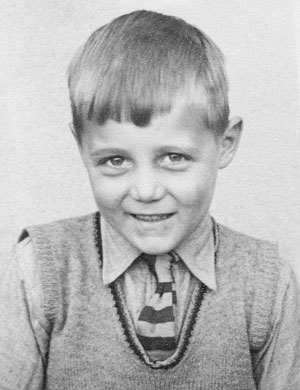
Hugh, 5 years old. |
| |
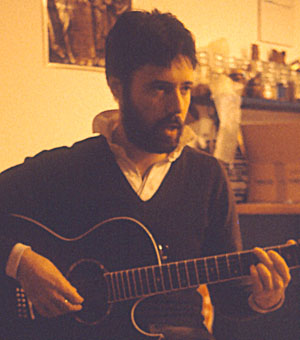
Hugh singing in Darmstadt,
Germany, summer 1979.
photo: © David John
See photo series 1. |
| |
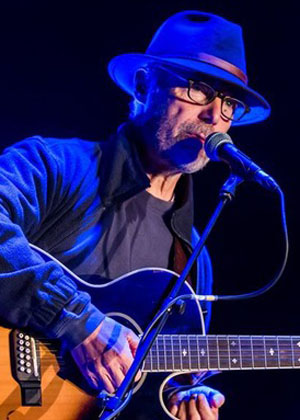
Hugh, 2019 edition.
photo: © Torsten Giesen
See news. |
| |
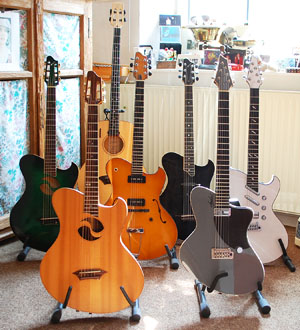
Hugh's Kraushaar guitars
photo: © Hugh Featherstone
For a larger photo and technical
details, see photo series 3. |
|
| |
Best Foot notes
By David "call me pedantic" John |
|
|
1. Echoes of Hugh's sojourn in Greece can be found in some of his early songs, particularly Thursday at Eleven (on the Announcer LP):
"All about, your precious marble ruins
Make a virtue of decay" |
|
|
2. The bruvver
Hugh's older brother, Graham "Henry" Blyth, is something of a legend among techies in the music industry. Among his many achievements he co-founded the company Soundcraft. He played keyboards on some of Hugh's early recordings, most notably those that eventually appeared on the Empty Houses LP. He also played with the band Rinky Dink and the Crystal Set, who may be remembered for their 1975 album Cameo Roles. |
|
|
3. Bangor, North Wales
Marc D’Aboville studied at the University of North Wales (UCNW) in Bangor during the same period as a number of later-to-be famous students, including the artists Ed Povey [see note 4] and Peter Winstanley, the director Danny Boyle and the actress Frances Barber. A quietly charming and soft-spoken guy, Marc was (and presumably still is) a prodigious guitarist, excelling especially on the electric guitar. He made a major contribution to the then thriving - and pioneering - "underground" arts and music scene in Bangor during the 1970s, notably as a member of the infamous proto-punk band Dick Dick and the Dicks with Tony Travis (bass), Brenda Prescott (vocals), Owen Hughes (drums), Roy Smith (percussion).
Marc played in Hugh's band Best Foot, whose shining hour was the BIG 1975 concert in the Theatre Gwynedd, with Chris Gibbs on bass and Owen Hughes (Hot Water, Fay Wray ..., later Cobb Records) on drums. Ed Povey also played an impressive set, solo and in duet with Hugh. A bootleg recording of the concert went into circulation among fans (see discography).
After leaving Bangor Marc played in a number of bands, notably the Amsterdam-based Red Archibald and the Internationals (1980s).
One of the venues of the Bangor scene was the Up Club, run by Hugh and David John at the Le Provençal a cafe near the university on Holyhead Road, where music, poetry and comedy sketches were staged. Who could have thought that so much fun could be had without alcohol or drugs (except caffeine and tannin)? We tried in vain to encourage Welsh-language artists to participate, but those we approached preferred to eshew the company of anglophones and remained in their self-constructed cultural ghetto.
Another contemporary band of note in the Bangor scene was The Inadequates, fronted by Scott Saunders (guitar, vocals, songwriting). Outrageous, iconoclastic, fantastic, they took Punk attitude to another level. During an early incarnation, Roger Greatorex, trans-scientist, pan-galactic script-writer, playwright and actor, played drums. For a while Roger and Hugh lived in the same house on Holyhead Road, infested with heady mix of scientists and arty types.
Probably the best-known Bangor band of this period was Hot Water (for whom I designed some posters). Hugh played a gig with the band at the Glanrafon Hotel (then a lively alternative venue) during his brief revisit to Bangor in 1977. Later, as Fay Wray (shortened from Fay Ray & the Rubbermen), they became a favourite of the legendary BBC DJ Jon Peel, recorded a Jon Peel Session, and almost attained stardom with their pop-rock album Contact You.
Some local bands managed to record their music during this time, but surprisingly few photos were taken at gigs and events, so photographic relics are rare. This was all just a few years before everybody began photographing everything and the video camera became de rigueur. Tony Travis (Dick Dick and the Dicks, Fay Wray) once drew an elaborate family tree of some of the Bangor bands of the 1970s-1980s, showing how groups evolved and mutated, and how musicians migrated from one combo to another (all very incestuous) or formed their own.
See Tony's blog: turquoisecoal.blogspot.com. |
|
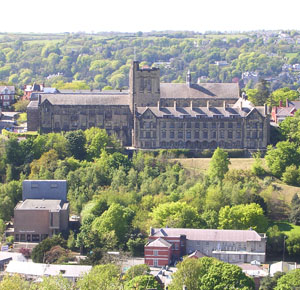
The Arts Building ("Top College") of
Bangor University, and below left the
Theatre Gwynedd (now demolished).
photo: © David John 2005
See a panoramic view of Bangor
(opens in a new window) |
4. Edward Povey
Before studying in Bangor in the 1970s, the multi-talented painter and sculptor Edward Povey had travelled through north America, where he honed his skills in Blues and Folk guitar-playing and singing. He wrote a large number of wonderful songs, some deep and thoughtful, others hilarious, including some ingenious satirical numbers (e.g. There's an egg parked on our city and I hope it goes down with the people). He made a few limited edition cassette albums, notably Nutmeg. He played innumerable concerts in North Wales and travelled throughout the British Isles, from Brighton to the Shetlands, delighting audiences at concerts and private gatherings with his musicality, wit and wisdom.
His great personal presence also manifested itself in comic acting. With David John he wrote and performed the partly improvised short play Evening Standards, about a millionaire and a street newspaper seller swapping roles, a Prince and the pauper type story - some years before the movie Trading Places (with Eddie Murphy and Dan Akroyd) explored the same theme. The tongue-in-cheek comedy was first performed at what probably remains the world's smallest arts festival, organized by Ed and held over a weekend in his tiny house in the Welsh village of Bethesda. The house bulged at the seams with people, and the audience spilled out into his back garden. Many local people were astonished and delighted that such an audacious and completely unprecedented event was actually taking place in their village.
Ed's initial fame as an artist followed the completion of several impressive large-scale mural paintings on buildings around Wales. Unfortuntely, he later decided to give up songwriting and performing in order to concentrate on his art career which, after much struggle, eventually proved very successful.
Hugh used two of Ed's paintings for the covers of his CD albums West of Eden and Negotiations and Lovesongs.
See Also Hugh's article about Ed Povey on the West of Eden page in the discography.
Edward Povey's website: www.edwardpovey.com |
|
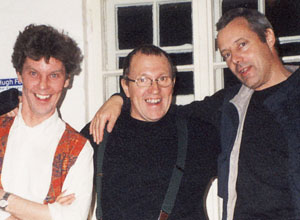
l-r: David John, Ed Povey and Hugh,
during Hugh's first concert at
the Werketage, Berlin, 2002.
The first meeting of the three
since 1976 in Bangor.
See photo series 4. |
5. The Darmstadt years
For further information about Hugh's life and times in Darmstadt and the Frankfurt area (Rhein-Main) and his collaborators there, see:
the Empty Houses, Largo, Announcer, "Black Tape" and "Yellow Tape" discography pages;
photo series 1. |
|
|
6. Wife and kids
Rock stars and movie stars do not have families, of course, a convention intended to present them as ever-eligible, and partly to protect their privacy.
Hugh has consistently credited his family members with their contributions to and support for his work, without making a big deal about it. His indefatigable wife Martine Passagez, amongst other things, took many of the photos for Hugh's albums.
Hugh's three children Sara, Kim and Philip are now themselves married with kids, pursuing lives and careers in various countries. Sara and Kim (aka Kim Bastian) made their recording debuts at tender ages as members of the Favourite Girl's Choir on the intro to Hugh's song My favourite planet (Negotiations and Lovesongs CD).
Kim's ethereal, heart-melting voice adorns several of Hugh's recorded songs, perhaps most outstandingly on Queen of broken things (Live at the Chapel CD). She has performed with Hugh on concert and festival stages all around Europe.
As a rock-steady, ever-ready drummer Philip (aka PhilBY) was a founder-member of Hugh's band A Panel of Experts (see Live at the Chapel CD). As a graphic designer he has provided photos, illustrations and cover designs for Hugh's CDs Landing, An American dream, Live at the Chapel, Friendly Skies and 9 on the sub-prime, as well as designing Hugh's official website and the music marketing web-portal blutopia.networks. He currently lives in Noo Yawk.
PhilBY's website: nemodreaming.com |
|
|
7. Hugh's guitars
See photos of some of the guitars used by Hugh in photo series 3.
Although I have seen Hugh playing a Washburn 12-string guitar and he has been photographed doing so a number times (see, for example, the "Black Tape" and news pages, and photo series 1), I hadn't realized until reading this that he had two of them. Two of them! How did that happen? I obviously haven't been looking or listening closely enough. Then I remembered that Hugh had sent me a photo of the two together back in 2015, and it has now been added it to photo series 3.
In 2008 Hugh wrote more extensively about his guitar collection and stage set-up at that time.
"Currently I’m playing 3 custom-built Kraushaars:
Stageplayer Hugh Featherstone acoustic (Fishman system)
Stageplayer Special baritone electro-acoustic (bass A, long scale, EMG magnetic plus Fishman system)
Stageplayer Fusion electric (2 x P90 magnetic)
I string 12-gauge Elixirs on the HF acoustic (that's the green one), heavy Fender Bajas on the baritone (the blue one) and Thomastik-Infeld 12-gauge Bebop round-wound on the Fusion electric (the butterscotch one). I use no pedals or effects on my guitars other than whatever reverb complex ("large room" or equivalent) is available at the mixer. That's not because I don't like effects, but because I'm too stupid to work them properly and sing at the same time.
I may from time to time turn to my Fender Stratocaster and/or a unique old Hofner archtop from the early '50s for a song or two. However, the beautiful Launhardt & Kobs acoustic, strung with 12-gauge Adamas, which was so evident on Landing and Friendly Skies, is an instrument I keep only for studio use.
The Kraushaars run through a Lehle no-loss guitar router, so that I can leave them on tap, into a 1980s Russian-built Petersburg 100 Watt, all-tube amplifier. This totally un-boutique, non-custom plain Jane of the amp sorority (weighs a ton, hums like a fridge, sometimes picks up Russian radio, otherwise sounds great [found Jimmy Page from Led Zeppelin using one]) drives a brace of 2x12 open-backed Marshall cabinets, each equipped with an unmatched pair of Celestion speakers: G12 Vintage and G12 Heritage." |
|
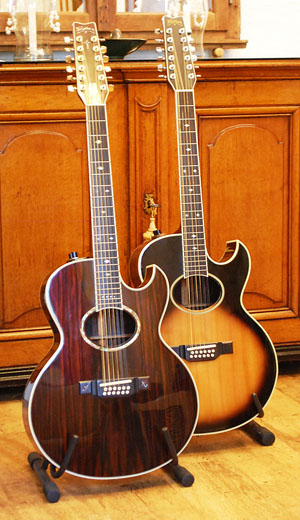
Hugh's two Washburn 12-string guitars.
photo: © Hugh Featherstone
See a larger photo in photo series 3. |
8. This gun's for hire
These projects include Hugh's recent collaboration with Slow Night and LoKal Heroes (see the discography page). |
|
|
| |
|
| |
| |
About this website
featherstone online since 2003 |
| |
This is a "fan" website dedicated to Hugh Featherstone and his music, designed, compiled and partly written by the Welsh artist, designer and writer David John.
I met Hugh at one of his concerts in April 1973 (Temperance Hotel, Bangor, North Wales), during a tour of Wales he made with other musicians, and became an instant fan (just add water). We have been friends since.
The first experimental version of this website was designed in the mid 1990s, shortly after the release of the first ever web browser Mosaic. However, at that time few people had internet access, and web-surfing with ye olde modem and an analogue telephone connection was expensive and very, very, s l o w, so many considered there would be no demand for such a publication. More than one pundit was of the opinion that the internet as a medium of mass communication "has yet to prove itself".
Being an obstinate so-and-so, I continued exploring the possibilities of the world wide web, designing and contributing to websites for artists, musicians, theatres, cultural organizations and firms. I put another version of the featherstone site online in 1998 as part of my own art and design website dadada-design ("more Da than Da Da"), which continued to develop as davidjohnberlin from 2003. The first freestanding version of featherstone (.co.nr) went online in the same year.
Hugh has been very supportive of the project, although he meanwhile has his own official website (designed by his son PhilBy), and has generously contributed photos, updates and further information, including lyrics and extended notes to his songs. Over the last few years he has concentrated more on his Facebook page and YouTube channel, so I have received less info directly, and believe there is little value in copying Facebook stuff here. I do sometimes republish info from other sites, particularly material likely to be online only for a short time.
Thanks also to the photographers who have allowed their photos to appear on this site (see the photographers page).
Occasionally I receive e-mail feedback from Hugh's fans, old friends and acquaintaces as well as former musical and artistic collaborators, which I pass on to him (all part of the service).
If you have any photos of Hugh and/or his concerts, reminiscences or comments you would like to contribute to this website, we would love to hear from you. Please get in contact.
As mentioned elsewhere on this site, Hugh's uplifting song My favourite planet provided the inspiration for the name of my present main internet publishing project (see the article on the News page).
Launced in 2008, the website www.my-favourite-planet.com, to which Hugh has contributed several poems and articles, began as an online travel guide, but has been gradually developing into something else. Just what it will develop into time will tell, but as Hugh once sang "it's time for a change". Plus ça change!
David John, March 2020 |
|
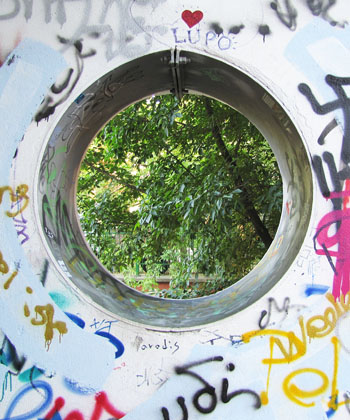
"The Garden of Eden wasn't far away,
not far away from here
Cool breeze, green trees ... I remember."
The Garden of Eden, Hugh Featherstone, 2003
photo: © David John |
| |
|
| |
| Hugh Featherstone plays Kraushaar Guitars |
| |
| |